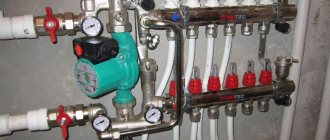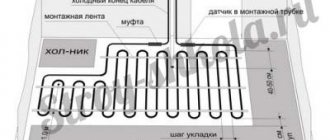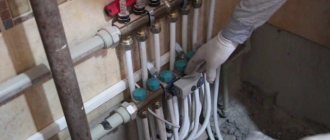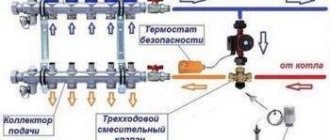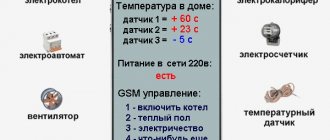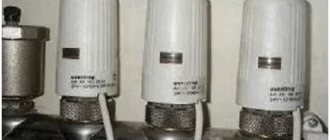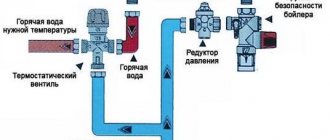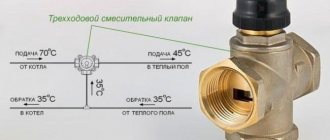The popularity of individual heating systems , called underfloor heating, is constantly growing. It's convenient, comfortable and not too expensive. But the main thing that interests everyone is the control of heated floors. Constant operation of this system is effective, but not very economical, so the ability to turn the floor on and off and change the heating level is very important for such a system. Heated floor control can be carried out in forced, automatic or remote mode.
Ability to control water heated floors
There are currently two underfloor heating systems in use:
- With liquid coolant
- Electric
Plain water is usually used as a coolant. Controlling the temperature of a water floor is technically implemented using more complex methods than controlling electric floors. Such warm floors are usually used in private homes where there is an individual gas boiler.
A regular valve is installed on each circuit, with the help of which the flow of hot water is regulated. Thus, the temperature is set manually.
Heated floor installation
It is advisable to find out in advance what the temperature of the warm water floor is. The fact is that, on average, such heating systems are capable of creating temperatures at foot level of up to +22°C and up to +18°C at head level. If such indicators are not acceptable for you or, purely technically, you cannot withstand such a temperature, it is quite possible that you will have to select another option for arranging your heated floor.
Water heated floor installation
In order to know to what temperature the heated floor is heated and how, in principle, this indicator can be regulated, it is necessary to have an idea of the structure of this heating system. First you need to remember that the floor of this design consists of 3 layers. Only such a layer cake allows you to create the effect of a warm floor in a room.
The first layer is a concrete screed, on which a special heat-insulating and waterproof substrate is laid. Its task is to retain heat and protect the rooms below from water leaks. It protects the pipeline from mechanical damage during installation.
The second layer is the pipeline itself, in which the coolant (hot water) circulates. Such a pipeline is usually made of metal expanded clay pipes, although they can also be simply metal. Unlike other underfloor heating systems, water flooring is considered completely safe and economical.
The third layer is a concrete screed covering the pipeline. A finished floor covering, such as laminate or ceramic tiles, is laid on top of such a screed. This coating must be heat-resistant and resistant to moisture.
Electric heated floor installation
In order to decide what temperature to set for a heated floor, heated floor systems are equipped with a control panel, with which you can adjust the temperature generated by such a floor. It can be either purely mechanical or automatic, providing remote control of all systems.
At the same time, the homeowner should always remember that this heating system is auxiliary. In principle, it is not capable of heating a room alone, so it is usually used in conjunction with the main heating system. Knowing its indicators, you can calculate what temperature of the heated floor should be set at this or that time of the year, taking into account the operation of additional heating equipment.
Automatic control mode
In automatic mode, each room has its own circuit and thermostat, where the desired temperature mode for a given room is selected. Each circuit is equipped with a servo drive that changes the flow of coolant , thereby regulating the temperature in the room.
Structurally, it looks like this. Each room has a temperature sensor that constantly measures its value at a certain point and transmits data to the heated floor control unit, the core of which is a programmable controller. If the air temperature changes from the specified limit, the controller sends a command to the servo drive, which regulates the flow of coolant into the system. changes to the specified level . A timer is connected to the controller, which allows you to program the temperature in each room depending on the time of day.
Heated floors can also be controlled remotely. Typically, water heating systems in private homes are made using a two-pipe circuit with a circulation pump, so the simplest remote heating control system includes a GSM socket to which the pump is connected. It is impossible to regulate the temperature in this way, but it is quite possible to turn the heated floor on or off using a command from a mobile device. When the circulation pump is turned off, the coolant returns through the bypass without entering the heated floor circuits.
Ready solution - Salusi T600 Smart Home
The Salusi T600 SmartHome complex can be considered a universal heating control system. This is a ready-made Smart Home solution that performs all the necessary functions, including controlling heated floors. The Salus system provides remote control of heated floors or heating radiators via the Internet or from a smartphone using a special application. There are two versions of the system, one of which involves laying wired lines between the elements, and in the other, communication between the temperature sensors, controller and servo drive is carried out via a radio channel.
Features of a warm water floor
A water-based underfloor heating (WF) is a coil - a special pipe design, the ends of which are fed to the heating and hot water supply system. To briefly describe the installation process, the coil tubes are laid on the required floor area and filled with cement screed or covered with special dry mixtures.
Next, in the usual manner, comes the final finishing of the room, including laying the floor covering, for example, tiles, which are suitable in technical parameters for a device for a warm water floor and satisfy the wishes of the household.
Features of water-based underfloor heating include:
- ease of installation - a plumber with average knowledge and little experience can do it, or the apartment owner himself, if he understands plumbing;
- there are no restrictions on area - the TP can be laid in almost any configuration, making it double-circuit or more (for this you will need a plumbing comb);
- freedom in choosing the connection method - the TP can be powered by central heating pipes, by a common riser with hot water supply, by a gas or electric boiler;
- low resource consumption compared to electric TP or due to injection of hot air from ventilation;
- versatility - the TP can be installed in almost any type of room:
- safety and ease of use - just turn the tap and fill the coil with hot water, the floor will quickly warm up.
Electric floor heating control
Electric heated floors, thanks to their design features, are much easier to control using various remote systems. For an electric heated floor, you only need a 220 V network and a control device. The easiest way to control an electric heated floor is through a smart socket using “on-off” commands from any mobile device.
Regulators are available in several different designs:
- Electromechanical
- Digital
- Programmable
Electromechanical regulators allow you to regulate the heating of the heated floor manually. On the body of the device there is a temperature regulator that can be set to the required value. Such a device is very reliable and inexpensive , and in case of breakdown it is easily repaired. The digital controller performs the same functions, but is made on a modern element base and has touch buttons.
The most versatile device is a programmable thermostat . This is a full-fledged multifunctional device that can be integrated into a comprehensive Smart Home control system. Temperature sensors are connected to such a device, and the built-in controller controls floor heating using a dimmer. The system allows you to maintain a set temperature in one room.
Thermostat MCS 350
The MCS 350 thermostat can be considered a successful solution for domestic use. The Teplolux Premium system is used to control various heating systems. The heated floor can be controlled from a touch wall panel and from any mobile device on which the appropriate application is installed. The device operates on a Wi-Fi network through a home router.
A home network allows you to combine up to 32 regulators , which will provide all rooms of a large house with a comfortable temperature. The delivery set includes two temperature sensors, one of which is located on the wall, and the other sensor has direct contact with the heated floor. This connection scheme provides temperature control according to two parameters. Using the MCS 350 thermostat, due to rational temperature control, allows you to save energy.
Useful video on setting up a thermostat
Automation functions
An automatic thermostat is capable of performing many functions in adjusting the intensity of heating a room using a water floor:
- Determines the heating temperature of water in the pipeline, turns on or off the circulation pump. This type of control of water flow in a pipeline is suitable for apartments and houses in which several pumps are installed. If there is one pump for the whole house, then the system will turn the heating on or off (depending on the water temperature) in all rooms at once.
- Semi-automatic control of the thermal head is quite simple and inexpensive. Allows you to regulate the intensity of water supply: the valve closes or opens depending on the degree of heating.
- Control is carried out by installing a servo drive on the collector; with its help, the heat supply to individual rooms is simultaneously regulated.
- A modern automatic thermostat can save up to 1/3 of gas consumption or 1/7 of wood for heating a room. Can adjust the degree of heating depending on the weather outside. Such a controller for a heated floor has many sensors, some of which are mounted outdoors, the rest indoors. Based on their readings and the settings, the heating intensity of each room is adjusted individually.
The heating temperature sensor can be installed inside or outside. It is not recommended to install a thermostat in the bathroom, kitchen or other rooms with high humidity. About wireless automation in adjusting heated floors, watch this video:
If underfloor heating is used as the main system, it is better to purchase a thermostat that regulates the level of air heating in the room.
If you have laid a floor covering that is not resistant to high temperatures, then it is better to install a floor heating sensor.
For the main water heated floor system, it is better to install a device with the ability to connect two sensors.
Control of heated floors from a remote control
There are inexpensive control systems that allow you to remotely change the temperature within one room. They use an executive module and a heated floor control panel. It has a design similar to home appliance remote controls and operates on infrared rays. The TR-810 thermostat is a device that provides temperature setting in the range from + 5 to + 350C at a load of 3.5 kW and a current of up to 16 A. The remote control provides control of the TR-810 executive module at a distance of up to 25 meters. One remote control is designed to control four actuators.
Circulation pump control
This is the simplest type of control: depending on the temperature of the coolant, the pump will turn on/off.
To implement this method you do not need a lot of knowledge or special qualifications. And the “automation for heated floors” is not used here: it’s just a room thermostat and nothing more.
The circulation pump control diagram looks like this:
As you can see, there is a thermostat installed in any room; when the set temperature is reached, the thermostat operates and turns off or turns on the pump.
This is how you can easily control the floor temperature automatically:
Here the thermostat monitors the readings of a sensor mounted in the floor between (and not on one pipe!) the pipes. The sensor gives a command to the thermostat, which processes the received signal and turns the circulation pump on/off.
Disadvantage: if there is one common pump for the whole house, then this method is not always suitable, because the pump is turned off by a thermostat installed in one room, and when the pump is turned off, the heating will stop throughout the house. This method is suitable if there are two pumps, for example, on different floors, and you need to control the heating on one floor without touching the second.
Water floor components
Creating such a floor is quite a difficult task. You must be able to carry out calculations, draw up diagrams, and specify the necessary materials and components. In addition, you need to have the skills to work with many tools to carry out correct and competent installation. If desired, you can create a heated floor yourself and configure its operation yourself, armed with the necessary knowledge.
Water-type heated floor design
The main components of a water floor are:
- Water heating boiler. For a heating system, its selection is carried out according to power. It should be 20% more than the total power of the heated floors being serviced.
- Pressure type pump (circulation). It can be included in the design of the boiler, be its integral part, or it must be purchased separately and installed in the heating system.
- Expansion tank. Must be present in the heating system to compensate for thermal expansion. Selection is carried out according to capacity. It depends on the volume of coolant located in the floor pipe system. Typically, the volume of the expansion tank is 10% of the volume of coolant poured into the system.
- Pressure gauge. The device monitors the pressure in the system.
- Ball and shut-off valves. Ball valves are located at the inlet of the water heating boiler, and shut-off valves are located at the inlet and outlet. Shut-off valves are used to carry out repair and maintenance work without draining water from the entire system.
- Pipes. To lay the route under the finishing coating, products made of polypropylene, including glass fiber reinforced, cross-linked polyethylene or metal-plastic, are used. Diameter 16÷20 mm. The requirements for them are as follows: they must withstand a temperature of at least 95 C and a pressure of 10 bar. Typically, such pipes are labeled “for heating.” The pipes being laid are attached to a special reinforcement mesh. They are secured using clamps made of plastic in increments of 100 to 300 mm. Options for laying pipes are very different. They can be laid in the form of a snake, spiral, loops, double snail, etc.
Pipe laying examplesCollector
Thermal head control
Let's say there is a mixing unit with a three-way valve in front of the manifold:
A thermal head is screwed onto this valve, to which a temperature sensor is connected. The sensor is installed on the pipe in which we want to control the temperature (it can be directly on the supply or return manifold). And we set the temperature we need on the thermal head. Now, based on a signal from the sensor, the thermal head will close or open the three-way valve, thereby adjusting the temperature of the coolant to, again, the desired parameter.
